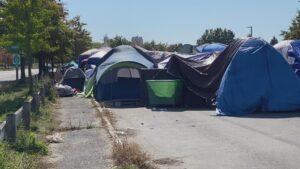
Cam Gordon
BY CAM GORDON
Power struggles over how to respond to encampments came to a head in September, following two fatal shootings near southside encampments.
“We need to put a stop to these,” said Mayor Jacob Frey, referring to the encampments, following the second shooting death on Sept. 18.
Outdoor camping in the city is prohibited by city ordinance. However, group camping has become common since the well-known Wall of Forgotten Natives encampment on Franklin Avenue, which captured national attention in 2018. During the COVID public health emergency, more were established, and permitted.
Since then, under Frey’s direction, the city has adopted a policy of evicting campers and clearing encampments by force.
The city’s website identifies 209 unhoused people sleeping outdoors at 32 encampments as of Sept. 21.
Meanwhile, on Sept. 19, the city council passed an “Encampment Removal Reporting Ordinance” that requires quarterly reports from city staff on the encampments, including the services offered, 311 and 911 calls and costs. This passed on a 9 to 4 vote with Council Members Michael Rainville, LaTrisha Vetaw, Jamal Osman, and Linea Palmisano voting against it. It was authored by southside council members, Jason Chavez, Aisha Chughtai and Aurin Chowdhury.
“This will help better inform changes that may need to happen at the city level,” said Chavez.
“Every encampment sweep costs the City about $120,000, amounting to millions every year,” said Chughtai. “Elected officials have an obligation to be transparent with the public on how their tax dollars are being spent, that is exactly what this ordinance does.”
Southsider Daniel Suitor, a housing attorney who lives in the Powderhorn Park neighborhood, favored the ordinance and attended the meeting where it was discussed. “The reporting ordinance is great because we will get data.” he said. Regular reports, he believes, will help everyone better understand the problem and target investments where they will do the most good.
When it comes to encampments, differences of opinion are easy to see, both at city hall and in the community. Some, including Suitor, favor a more permissive and even supportive approach. While others, like the mayor, prefer a more authoritarian and prohibitive approach.
 But almost everyone appears to agree that the current situation is dangerous, that substance abuse disorder is part of the problem, and that what we are doing now about it is not working.
But almost everyone appears to agree that the current situation is dangerous, that substance abuse disorder is part of the problem, and that what we are doing now about it is not working.
Frey said. “The encampments are not safe for the people living at them, they are not safe for the overarching neighborhoods.”
“The residents are scared,” said Minneapolis Police Chief Brian O’Hara.
“I worry about escalating violence,” said Suitor. “It’s really scary to see the escalating violence against unhoused people.”
Jennifer Gilreath, a Phillips West resident who has lived near, and provided help to those staying in encampments, agrees. Following the recent evictions, she said “we have 200 people now roaming around trying to figure out where they are going to stay.”
“We know that sweeping encampments doesn’t solve homelessness,” said Suitor, “and we know encampments don’t end homelessness.”
“We close one here, it pops up over there,” said O’Hara.
“It is a serious, serious issue,” he added. “We are looking forward to working with everyone we possibly can to do their part to help us prevent things like this in the future.”
Maybe now is the time to explore alternative approaches. Other cities have, and Gilreath and Suitor think it is possible here.
Even the city’s own ordinance currently empowers the director of regulatory service to permit camping to address an emergency And last December the city council declared “unsheltered homelessness a public health emergency.”
In July, the council also formally referred an ordinance amendment to a committee that was introduced by Chavez, to allow and regulate “safe outdoor spaces and individualized outdoor sheltering options for people experiencing homelessness.”
“We need short- and long-term solutions,” said Gilreath, who wants the city to designate one of their many vacant lots near her home to be a model for a permitted and well managed encampment. With the right resources, including trusted violence interrupters to provide security, and supportive neighbors to assist, the camp could provide a stable place for people to access services.
She said that previous well-managed encampments, like one near a gas station on Bloomington Avenue and another in Brackett Park during the COVID pandemic, that were for woman and children only, could be examples to learn from.
Gilreath also thinks it is time for the city to create a tiny-home village on the southside, as other cities have done. There are already tiny-house communities in Dallas, Madison, Seattle, Portland and Austin, where formerly unhoused residents live in tiny homes and RVs.
The city could use the $1 million they voted to set aside in this year’s budget to help fund a new tiny home community, that they were hoping Avivo would develop. If the Avivo proposal is no longer viable, perhaps that money could be used to build a smaller outdoor version, modeled after the Street Voices of Change and Envision Communities cluster development proposals.
Gilreath wishes that the city would follow the recommendations of the Nenookaasi Healing Camp, which calls on the government to work with organizers to provide sanitation, water, and security, as well as healthcare and addiction treatment and recovery services to camp residents.
They also suggest that every encampment closure include real options of alternative, culturally appropriate, dignified housing for those who want it, or if no other options are available, pay for individual hotel or motel rooms for those who need and want them. They encourage the city to start using vacant schools, hotels, or apartment buildings to set up “well-resourced, and welcoming navigation centers.”
“The gold-standard is a housing first approach,’ said Suitor, who has lost clients because a camp was torn down, phones and paperwork were taken, and he had no way to reach them. “Camps make it easier to help people because you know where they are,” he said.
Frey agreed with Suitor when he said, “we believe in strategies of low and no barrier housing.” Yet, most options have barriers. Some don’t allow pets. Many require sobriety. Some don’t allow couples or families to stay together. Many allow only a few personal possessions and have no safe storage.
Suitor agreed that one option to consider is designating spaces where people can stay in vehicles where, ideally, residents can feel safe and access clean water and other basic amenities. This could be in a parking lot with the cooperation of a place of religious worship, other private property owners, or on public land.
Suitor calls on us to prioritize shelter for people with substance abuse disorders and create more supportive housing arrangement that can “move people toward treatment.”
Nenookaasi’s guidelines call for “overdose prevention and safe use sites” as a way to “meet the needs of people in addiction cycles and help keep neighborhoods safe.”
“We are entering winter,” Suitor said. “This is the most dangerous time for unhoused people.”
Maybe now we can try something different. It might save lives.






















